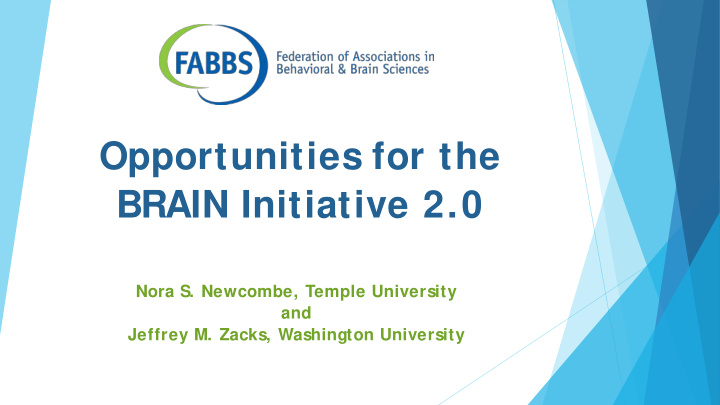



Opportunities for the BRAIN Initiative 2.0 Nora S. Newcombe, Temple University and Jeffrey M. Zacks, Washington University
On behalf of member societies: American Educat ional Research Associat ion • American Psychological Associat ion • Associat ion for Applied Psychophysiology and Biofeedback • Associat ion for Behavior Analysis Int ernat ional • Behavior Genet ics Associat ion • Cognit ive S cience S ociet y • Int ernat ional S ociet y for Development al Psychobiology • Massachuset t s Neuropsychological S ociet y • Nat ional Academy of Neuropsychology • The Psychonomic S ociet y • S ociet y for Behavioral Neuroendocrinology • S ociet y for Comput ers in Psychology • S ociet y for Judgment and Decision Making • S ociet y for Mat hemat ical Psychology • S ociet y for t he Psychological S t udy of S ocial Issues • S ociet y for Psychophysiological Research • S ociet y for Research in Child Development • S ociet y for Research in Psychopat hology • S ociet y for t he S cient ific S t udy of Reading • S ociet y for Text & Discourse • S ociet y of Experiment al S ocial Psychology • S ociet y of Mult ivariat e Experiment al Psychology • Vision S ciences S ociet y
Behavioral sciences are central to the goals of BRAIN 2.0 For example, Goal 7 aims to int egrat e new t echnological and concept ual approaches produced in Goals 1-6 t o discover how dynamic pat t erns of neural act ivit y are t ransf ormed int o cognition, emotion, perception and action in healt h and disease . (NIH BRAIN report, 2014; emphasis added)
Two key leverage points Revolutionary tool development (Phase I) Transforming dynamic neural patterns into understanding cognition, emotion, perception and action (Phase II)
Transformative technologies for ambulatory assessment Ubiquitous lightweight technology Eye tracking: New progress in wearable eye-and-head tracking Portable imaging techniques: EEG, fNIRS , and fMRI Body movement tracking: Relate neural control to naturalistic, dynamic behaviors Actigraphy: Unpacks dynamics of activity over longer time-scales, particularly crucial for studies of sleep/ wake, circadian rhythm
Transformative technologies for ambulatory assessment Linking brain data to behavioral data. We can utilize modern technology to gather very large population-representative data sets that can provide powerful analytic leverage on brain-behavior relationships-- where people are, what they hear and say, and what they think and feel: GPS data Real-time experience reports S ound– e.g., Lena recordings
Computational tools We need t o apply novel comput at ional t echniques t o modeling behavioral and brain dat a. Example: New dat a suggest t hat react ivat ed memories can ent er a "zone of dest ruct ion” in which t hey are weakened rat her t han st rengt hened. Wit h t he advent of real-t ime imaging and ment al-st at e classificat ion, it may now be possible t o “ t it rat e” t he level of act ivat ion t o keep t he memory in t he zone of dest ruct ion. Making it real– new virt ual realit y t echnology. This int ervent ion builds on a comput at ional model, inspired by neural mechanisms at t he *syst ems* level of analysis, providing a mechanism relevant t o t reat ment of ment al disorder.
Kriegeskorte et al., 2017 Computational tools Cognitive architectures Large-scale models of whole-organism neural control are essential for integrating smaller-scale data and models Neurophysiologically plausible deep learning Close the gap between microscale models that cannot capture phenomena of interest and macroscale models that violate known aspects of the microarchitecture Diffusion modeling and linear ballistic accumulator modeling Macro-scale “ thermodynamic” models of the computations underlying the computations leading up to an overt behavior Bayesian models of latent structure in behavior, including topic models Models of knowledge and belief updating can relate large-scale neural organization to individual and group differences in cognition
Relating brain activity to behavior on a moment-by-moment basis Computational cognitive neuroimaging Models that bridge neural levels and behavioral levels to relate physiological data to mental representation to behavior moment by moment Neurostimulation in complex behaviors (human and animal, invasive and noninvasive) There has been rapid growth in tools from invasive (inactivation, electrical stimulation, optogenetics) to noninvasive (TMS , tDCS) and from small to large The next revolution will be deploying these tools in free-ranging behavioral settings in the context of full task models Polania et al., 2018
Relating individual and group differences in brains to differences in cognition, perception, action Developmental brain-behavior relations require an augmented toolbox and new techniques Large-scale studies have the potential to transform understanding of how mental function relates to the development of brain structure and the expression of genes coding for neurotransmitters Computational psychiatry As we move beyond broad diagnostic categories, psychiatry needs fine— grained cognitive models of how alterations in brain function relate to alterations in behavior, characterized taking advantage of new knowledge
Relating paradigms across species We need meaningful tasks that work across species (humans, monkeys, and rodents at least) to increase translation As one example, we are never going to study human memory development using conditioned footshock
S trategic priorities for maximizing the contribution of behavioral science to the BRAIN initiative Goal should be FOAs targeting behavioral science, and FOA language encouraging teams led by (or incorporating) behavioral and cognitive neuroscientist s S teps towards this goal Advisory/ informational workshops Inclusion of behavioral and cognitive scientists on advisory committees
Recommend
More recommend